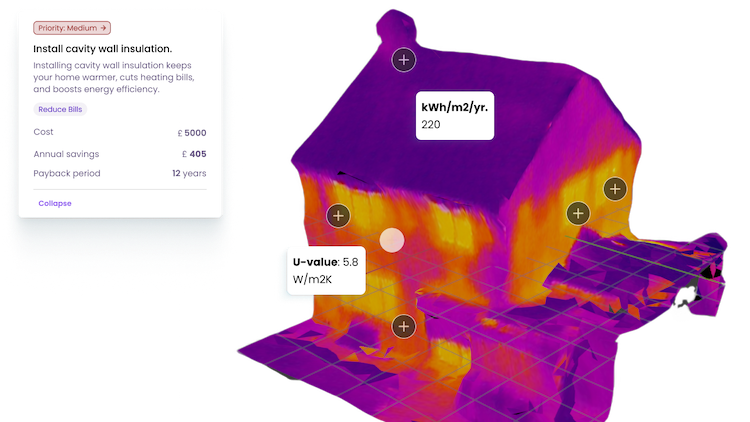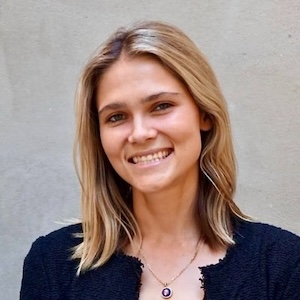
Six retrofits must take place every minute between now and 2050 for net-zero targets to be met. Can AI come to the rescue of this daunting challenge? Lucy Lyons, co-founder of tech startup Kestrix, explains how building the ‘Google Maps of heat loss’ could help.
“There is no scalable, cost-effective way of knowing reliably how heat is lost across the millions of buildings we all live, work and play in – let alone how to fix it and how much fixes will cost,” says Lyons, co-founder of the tech start-up.
Since forming in 2022, Kestrix has raised £1.7m, from a mixture of innovation grants and angel investors. It has recently won an Inside Housing net zero innovation award and created something of a buzz around the thorny issue of retrofitting homes.
The interest Kestrix has generated focuses on its new approach to surveying the heat losses of buildings at speed and scale. Lyons says this will be necessary if we are to meet net-zero targets. A total of 29 million UK homes require an upgrade, according to the UK Green Building Council. Yet EPCs overstate energy usage by 300% and onsite surveys are too expensive, sometimes costing more than £275 per home visit.
Lyons and her co-founder, Matt Goodridge, cannot solve the huge question marks over how such a huge retrofitting programme can be funded and delivered. Their part of the solution is to provide much-needed data to help social landlords plan and prioritise the work and in time aspire to build up a map of heat losses.
“We are building retrofit’s data layer, the ‘Google Maps of heat loss,’ as it were,” says Lyons. Kestrix uses thermal drones and AI to construct 3D heat loss models of buildings and reveal retrofit opportunities in seconds without the need for site visits.
BIMplus: So how did Kestrix start?

“We hear from everyone that EPCs are not fit for purpose – they give no idea how much it costs to run a house, how to fix it or even what’s wrong with it and where the heat is leaking from.”
Lucy Lyons I met my co-founder Matt Goodridge in Carbon 13 Venture Builder – a programme where you come in as a solo entrepreneur and you meet other founders in the same room and you’re all tasked with the challenge of building new ventures that have the potential to abate or avoid 10 million tonnes of carbon emissions per year. I’d worked in tech startups in Germany – although I’m originally from Boston – and had a spell at Plan A, which was the first B2B carbon accounting software platform to market in Europe.
A Master’s in sustainability and enterprise followed in the UK and after that I joined Carbon 13. I think biggest lesson for me when I was working at those other startups was especially at the beginning. It’s so much less about what you build and more about who you build it with and your relationships with those people.
That was my motivation for joining the Carbon 13 venture accelerator: there were lots of like-minded people.
Matt has a background in high-tech product management. He worked at Google for 10 years and has an academic background in engineering and computer science with a specialism in computer vision. He also had a keen interest in buildings and retrofit. But it wasn’t until we decided to work together that he revealed he had been working on a 3D heat loss model for housing. He also had a drone hobby and had been thinking whether it would be possible to spot leaks from buildings using drones.
For me, that’s when the light bulb went off, realising this is the non-invasive, highly technical way, specific to a building’s asset class, to figure out how to decarbonise a lot of buildings at once.
What happened next?
We hear from everyone that EPCs are not fit for purpose – they give no idea how much it costs to run a house, how to fix it or even what’s wrong with it and where the heat is leaking from. We put our idea to many people in the housing world and heard from the housing providers and contractors, “if you build this, we’ll buy it”.
A series of grants from Innovate UK have enabled us to develop an algorithm that can quantify heat loss from thermal images. The rapid thermal performance assessment (RaThPA) AI technology can estimate the loss of energy in kWh/m2/yr of each home in a housing provider’s stock. This allows asset managers to prioritise which buildings need retrofit attention.
What’s the significance of the RaThPAs algorithm?
Basically, it takes thermal imaging analysis to the next level. It looks at the thermal image captured by the drone and calculates heat loss quantitatively, so it estimates u-values of individual building material components and comes up with a measure of overall space heating demand intensity or heat loss.
“It takes thermal imaging analysis to the next level. It looks at the thermal image captured and calculates heat loss quantitatively, estimating u-values of individual building material components, and comes up with a measure of overall space heating demand intensity or heat loss.”
This is super useful if you’re a housing provider like Peabody, which is a collaborator on one of our projects, and you have got 100 to 4,000 homes that you need to decarbonise. You scan them all with our technology and you can understand from A-Z which home is the leakiest and which one needs support, without having to carry out multiple site surveys. That’s really important when housing providers are bidding for the Social Housing Decarbonisation Fund, where you have to ensure that the properties that go into the bid are EPC D or below.
I’ve spoken to housing providers who submit 1,000 homes for a bid and then perform PAS 2035 assessments on all of them and find that half of them are actually EPC grade B rather than D, forcing them back to the drawing board – after wasting hundreds of thousands of pounds on PAS 2035 assessments.
Who are you working with?
We’re working on pilots with nine large housing providers, including Clarion Homes, Peabody and Places for People, and we’re also working with the National Trust – testing the algorithm and developing its accuracy.
There are 12 of us working for Kextrix now. We’ve scanned about 1,900 homes with the drone and those images go through our system and the data goes back to the housing provider. We have a specialist thermographer and surveyor who can help identify thermal anomalies.
What’s the commercial model?
We basically sell surveys, and depending on the data granularity, you can get a full thermal assessment, which is a tiny fraction of the price of most thermography. Once this is working at scale, we’ll do some combination of software licenses and data licenses. So, if you’re a housing provider, you can use an API to plug our analysis software into your existing asset management systems.
Housing providers will also be able also license a dashboard to help organise the data. But we are still finalising our commercial arrangements.
“We’re really focused on accuracy. We want Kestrix to become reliable enough that it can be used as a national standard for home heat loss.”
What’s next?
The algorithm is still being honed – it’s a never-ending road, optimising algorithms. We’re really focused on accuracy. We want Kestrix to become reliable enough that it can be used as a national standard for home heat loss, bearing in mind that there’s not enough skilled people or resources and time to go around to every single home to figure out what we have to do.
The idea is that we would get into a position where we’re mapping every home in the UK and the system is being used by various stakeholders, like housing providers, but also energy companies, mortgage providers, government and installers.
We see ourselves as providing the blueprint for what needs to be done and then the hard part starts. Of course, it doesn’t solve all the problems. There are too few skilled people to deliver the retrofit work and the financing piece is missing.
But people say you can’t manage what you can’t measure – and you don’t finance it either. So private finance, as well as grant funding, cannot be allocated unless we can make a business case for why it should be allocated and where, and then also use that data to track progress and validate that funds are actually being used to reduce emissions and address fuel poverty.
Have the housing association pilot schemes been validated yet?
We are still working through the analysis of the properties we have scanned. When the the development of the algorithm is complete, we will be able to understand quickly what the priority is across a set of 3,000 buildings and that’s when we’ll start to see some return on investment.
I’m hoping that data can give us the push we need. As I said, it does more for unlocking financing than anything. And if you unlock financing, you create much more stability in the supply chain, and that’s really what’s needed to scale-up the workforce.
Don’t miss out on BIM and digital construction news: sign up to receive the BIMplus newsletter.












